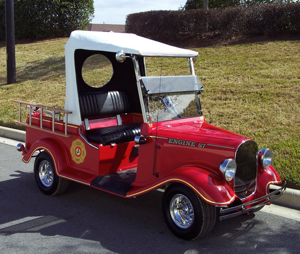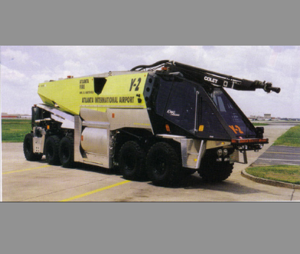The imagination of firefighters and apparatus designers is unlimited when it comes to creating apparatus to meet unique fire suppression challenges. Let’s take a look at what some of the outcomes of that imagination look like around the globe.
Our first example comes courtesy of the former USSR where they took a military troop carrier chassis and created a firefighting vehicle capable of firing “ordnance” consisting of water and fire retardant into forest fires from a safe distance.
 |
This vehicle affords firefighters the capability to traverse very rugged terrain — think brush truck on steroids — and deliver the fire suppression payload with devastating impact. It also enables fire suppression operations to continue during weather conditions that would preclude the use of aerial water drops. This vehicle is surely a welcome addition to the firefighting cadre in heavily forested areas that are common across that part of the world.
A similar use of a military chassis, this time using a track-drive, comes from the Chinese fire service. This firefighting machine provides not only master stream capability from its roof-mounted turret device, but also multiple discharge ports off of the rear of the vehicle to supply various sizes of handlines for mop-up operations or structural firefighting tasks.
 |
Closer to home, the town of Clifton Park, N.Y., has given a school bus a second career as a traveling fire prevention and safety unit for the community.
The members of the Vischer Ferry Fire Department refurbished the bus as a lasting tribute to one of its members and fire educator, the late Dave Bowen, who served the department for 38 years. He was the founder of the Shenendahowa Fire Prevention program and was named State Fireman Association Safety Educator of the Year in 2008.
 |
The bus is a mobile classroom for children and adults. Seats were removed and the inside was mocked up as three household rooms. In each room, instructors provide fire prevention tips.
One thing I’ve always appreciated was the way the fire services in other countries make use of specialized fire apparatus. Case in point, here’s an aerial device from the Japanese fire service that’s obviously been designed with a couple of critical high-risk, low-frequency tasks in mind. Rescue of occupants from upper floors of a structure and deliver an elevated large-caliber master stream. Period.
 |
You’ll also note the short wheelbase and design of the cab (including skid bars) to facilitate getting as close to the structure as possible for the most effective use of the ladder. Think it has something to do with the narrow and congested streets in cities like Tokyo?
This one never gets old in my book. This unique piece of fire apparatus comes from the Guardians of the Ribbon Pink Heals Tour. This rig, and others like it, are created and maintained by local chapters across the country.
It is one of my favorites because it and the firefighters of the Guardians of the Ribbon Pink Heals Tour travel the country to bring awareness to breast cancer and the threat that it poses to the women in our lives both at home and on the job.
 |
The Guardians are all volunteers and their operations are funded totally by the sale of Pink Heals merchandise sold at tour stops and online.
Each chapter’s trucks carries the name of a breast cancer victim (this rig bears the name Karen) and at each tour stop people are encouraged to write a message about a breast cancer survivor or victim in their lives anywhere there’s space on the truck. I added my own message in honor of my own personal breast cancer survivor at FRI in Dallas in 2009.
Lastly, here’s one that should hold a spot in the heart of all firefighters who also fancies themselves golfers, and a great many of us do.
 |
It looks like a fire truck and works like a golf cart. Talk about styling your way around the links.
More than just a body kit, this cart actually comes with oak ladders and flashing emergency lights. Assuming you’re an actual firefighter, you can get your own personal crest added to the side of the truck. Guess what just got added to my Christmas wish list?
OK, one more. This Colet S.V.D. KR/40, has been part of the fleet protecting Atlanta’s Hartsfield Airport since 1998. The difference between the KR/40 and a traditional fire truck is striking.
 |
When a turn is made in a standard truck, the centrifugal force sends passengers to the outside of the turn, sometimes making it feel like the vehicle is about to turn over. In a KR/40 the suspension system compensates for turns, making the centrifugal barely noticeable.
In addition to its strikingly good looks, the KR/40 is quite the airport firefighting machine. The unit carries 4,000 gallons of water, has an engine that delivers approximately 1,600 horsepower, an electronic active hydro-pneumatic suspension system, stainless steel chassis, an extremely low center of gravity, twin automatic transmissions, electronic traction control, anti-lock braking system and the aforementioned advanced stability system.


